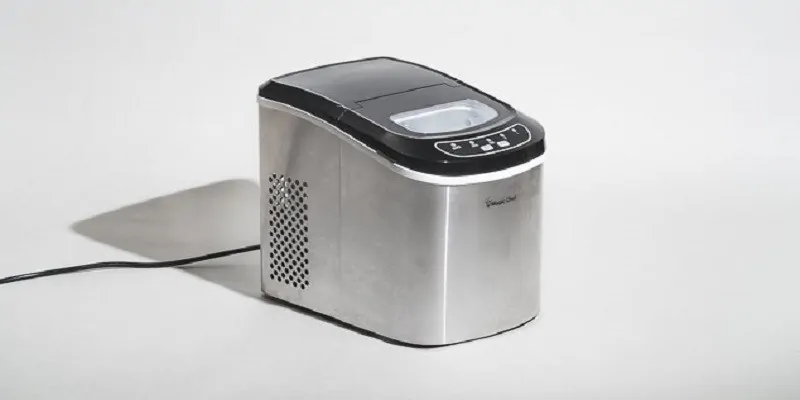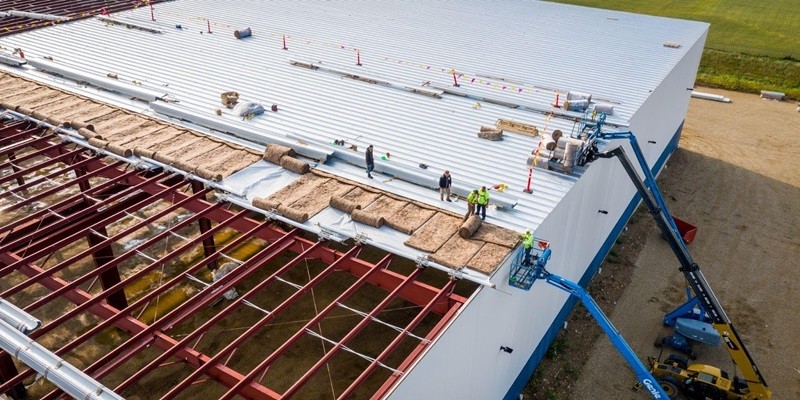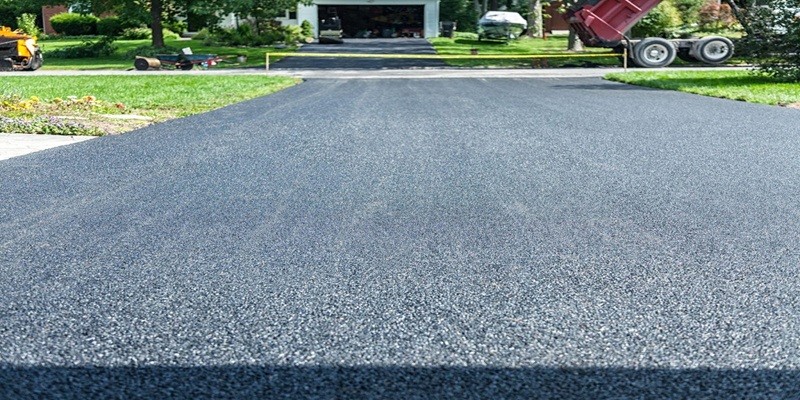Last Updated on October 15, 2023
To clean a countertop ice maker, wipe down the exterior and interior with a soft cloth and mild soap and water solution. Then, rinse with water and dry thoroughly.
A countertop ice maker comes in handy for those hot summer days when you need to cool down with a cold drink. However, like any other appliance, it needs regular cleaning to function efficiently. Without proper maintenance, it can easily accumulate dirt, mold and bacteria that can cause discoloration, foul odor, and affect the taste of the ice.
Cleaning your countertop ice maker is a simple process and can be done with basic cleaning materials such as a soft cloth and mild soap. This article will provide you with step-by-step guidelines on how to clean a countertop ice maker to keep it running smoothly.

Credit: www.youtube.com
The Risks Of Not Cleaning Your Countertop Ice Maker
Countertop ice makers have become increasingly popular due to their convenience and ease of use. However, many users overlook the importance of regularly cleaning them. Failing to clean your countertop ice maker poses significant risks, including the following:
Bacteria Growth And Contamination Risks
- Without regular cleaning, bacteria can quickly accumulate in the ice maker, contaminating the ice.
- Bacteria can cause foodborne illnesses that can lead to serious health problems, especially for vulnerable individuals such as children, the elderly, and those with weakened immune systems.
Poor Ice Quality
- Dirty ice maker produces poor quality ice, which melts faster, diluting your drinks, and compromising their taste and texture.
- The build-up of minerals and other impurities on the machine can also taint the ice, leaving it with an unpleasant aftertaste.
Shortened Lifespan Of The Machine
- Dirt and dust build-up on the machine’s internal components can damage the refrigeration system and other moving parts.
- Frequent usage without cleaning can also clog the drain or the water inlet, leading to malfunctions.
Increased Energy Consumption
- Accumulation of dirt and dust on the evaporator coils can lead to decreased heat transfer efficiency, causing the ice maker to work harder to produce ice, thereby consuming more energy.
- Regular cleaning of the machine can help you save costs on utility bills in the long run.
Taking the time to clean your countertop ice maker regularly is critical to ensuring that the ice it produces is clean, safe, and of good quality. It also helps prolong the machine’s life and save on energy consumption costs over time.
So, make cleaning your ice maker a regular habit to keep you and your family safe and your drinks refreshing.
How Often Should You Clean Your Countertop Ice Maker?
How To Clean A Countertop Ice Maker?
Are you the proud owner of a countertop ice maker? If so, you already know how convenient it is to have ice readily available whenever you need it. However, like all appliances, your ice maker needs regular cleaning to keep working efficiently.
Manufacturer’S Instructions
Cleaning your countertop ice maker is essential to prevent the buildup of mold, mildew, and bacteria, which can contaminate the ice and impair its quality. The manufacturer’s instructions will provide specific cleaning procedures and recommended cleaning products. Here are some general guidelines to follow:
- Unplug the ice maker and let it defrost for a few minutes.
- Remove the ice basket and any remaining ice from the machine.
- Wash the ice basket and ice scoop with warm, soapy water.
- Wipe the interior and exterior of the machine with a clean, damp cloth.
- Clean the condenser coils located at the back of the machine with a soft brush or vacuum cleaner.
- Run a cleaning cycle with a solution of water and a recommended cleaning agent.
- Rinse the machine with clean water and let it dry completely before plugging it back in.
Factors That Affect Cleaning Frequency
How often you need to clean your countertop ice maker depends on several factors, such as its frequency of use, the quality of the water used, and the surrounding environment. Here are some guidelines to follow:
- High use: If you use your ice maker every day, you should clean it at least once a month.
- Low use: If you use your ice maker occasionally, you should clean it every three to six months.
- Poor water quality: If your water source is hard or has a high mineral content, you should clean your ice maker more frequently.
- Dusty or humid environment: If your ice maker is located in a dusty or humid environment, you should clean it more frequently to prevent the buildup of mold and mildew.
Signs That Your Ice Maker Needs Cleaning
Regular cleaning is key to keeping your countertop ice maker in good working order. Here are some signs that indicate your ice maker needs cleaning:
- The ice cubes have a strange taste or odor.
- The ice cubes are discolored or have a cloudy appearance.
- The ice maker is producing smaller or irregularly shaped ice cubes.
- The ice maker is making strange noises or running more slowly than usual.
By following the manufacturer’s instructions and regular cleaning schedule, you can ensure that your countertop ice maker remains in excellent working condition. Remember to keep an eye out for any signs that your ice maker needs cleaning, and take action promptly to prevent the buildup of harmful bacteria and contaminants.
What You Will Need
Countertop ice makers are a convenient way to have ice on hand at your fingertips, but it is essential to keep them clean to ensure safe drinking water and maintain their efficiency. Here’s what you need to clean a countertop ice maker:
Cleaning Solution
A cleaning solution is a crucial element when it comes to cleaning a countertop ice maker, and you can either make it yourself or purchase it from a store. Here’s what you can use to create your own cleaning solution:
- White vinegar
- Lemon juice
- Soap
To make your cleaning solution, add two cups of water, one tablespoon of white vinegar, and one tablespoon of lemon juice or soap into a spray bottle.
Warm Water
In addition to the cleaning solution, you will also need warm water to rinse the countertop ice maker after cleaning. Use warm water to ensure that you get rid of all the cleaning solution and dirt.
Scrub Brush
You need a scrub brush to clean the inside of the ice maker and remove any grime and dirt buildup. Be sure to use a brush with soft bristles to avoid damaging the interior of the machine.
Soft Cloth
A soft cloth comes in handy to wipe the countertop ice maker after cleaning. Make sure you get a clean and dry cloth to wipe the machine thoroughly.
Gloves
Cleaning a countertop ice maker means getting your hands dirty, but you can protect them by wearing gloves. Rubber gloves are a perfect option for this job.
Now that you know what you will need to clean a countertop ice maker let’s dive into the cleaning process.
Cleaning The Interior Components Of The Ice Maker
If you’re a fan of ice-cold drinks, then you know the importance of having a countertop ice maker. But, like all appliances, it needs to be cleaned regularly to keep it functioning efficiently. We’ll be providing step-by-step instructions on how to clean the interior components of your countertop ice maker.
Removing The Ice Basket And Water Reservoir
To clean the interior components of your countertop ice maker, you’ll need to start by removing the ice basket and water reservoir. Here’s how:
- Turn off and unplug the ice maker.
- Remove the ice basket and the water reservoir from the machine.
- Empty the ice basket and discard the ice.
- Wash the ice basket and water reservoir with warm water and mild dish soap. Rinse them thoroughly and let them air dry.
Cleaning The Evaporator Plate
The evaporator plate is responsible for freezing the water and producing the ice. Over time, this plate can develop a buildup of minerals, which can decrease its efficiency. Follow these steps to clean the evaporator plate:
- Turn off and unplug the ice maker.
- Locate the evaporator plate (this is typically located underneath the water reservoir).
- Use a soft brush or cloth to gently clean the evaporator plate. Be careful not to damage the delicate fins.
- If there is a significant buildup of minerals, consider using a solution of equal parts water and vinegar. Soak the evaporator plate for 10-15 minutes before gently cleaning it with a soft brush or cloth.
Cleaning The Water Reservoir
Over time, the water reservoir can develop a buildup of minerals and bacteria. For this reason, it’s essential to clean it regularly. Here’s how:
- Turn off and unplug the ice maker.
- Empty any remaining water from the water reservoir.
- Wash the water reservoir with warm water and mild dish soap. If there is a significant buildup of minerals, consider using a solution of equal parts water and vinegar.
- Rinse the reservoir thoroughly and let it air dry before replacing it in the ice maker.
Reassembling The Ice Maker
Now that you’ve cleaned all the interior components of your countertop ice maker, it’s time to reassemble it. Here’s how:
- Make sure that all the components are completely dry.
- Place the water reservoir back into position and secure it.
- Replace the ice basket in the machine.
- Plug in and turn on the ice maker.
- Wait for the ice maker to make new ice before using it.
Cleaning the interior components of your countertop ice maker is a simple task that can help to keep it running efficiently. By following the steps outlined you can ensure that your ice maker is producing clean and fresh ice for all your cold beverages.
Cleaning The Exterior Of The Ice Maker
The exterior of your countertop ice maker is the first thing people see when they come into your kitchen space. Keeping it clean not only makes your ice maker look nicer but also helps to prevent dirt and grime buildup that can cause damage over time.
Wiping Down The Exterior With A Soft Cloth
Wiping down the exterior of your ice maker should be a regular part of your cleaning routine. Here are some key points to keep in mind when cleaning the exterior of your countertop ice maker:
- Always turn off and unplug the ice maker before cleaning the exterior.
- Use a soft, lint-free cloth to wipe down the exterior. Avoid using harsh or abrasive cleaning materials that could scratch the surface.
- Clean the surfaces with a mixture of warm water and mild detergent. Avoid using any harsh chemicals as they can damage the surface.
- Wipe down the exterior of the ice maker thoroughly with the cloth. Pay particular attention to any nooks and crannies where dirt and grime might accumulate.
- Once you’ve finished cleaning, be sure to dry the exterior completely to prevent water spots and other damage.
Cleaning The Ice Scoop And Storage Tray
Cleaning the ice scoop and storage tray of your countertop ice maker is important to ensure that the ice you’re making is fresh and clean. Here are some key points to keep in mind when cleaning the ice scoop and storage tray:
- Always empty the ice tray before cleaning the ice scoop and storage tray.
- Clean the scoop with warm water and mild detergent, just like you would the exterior of the ice maker. Be sure to rinse the scoop thoroughly to remove any soap residue.
- If the storage tray is removable, take it out and clean it using warm water and mild detergent. If it’s not removable, wipe it down with a soft cloth and the same mixture of warm water and mild detergent that you used to clean the scoop.
- Be sure to dry the scoop and storage tray completely before using them again.
Remember, cleaning your countertop ice maker doesn’t have to be a tedious or time-consuming task. By following these simple cleaning routines, you can maintain your ice maker’s appearance and ensure that it continues to function properly for years to come.
Alternative Cleaning Methods
Countertop ice makers are a great addition to any kitchen, but they require cleanup and maintenance after prolonged use. While some people use traditional cleaning methods, using natural cleaning solutions is a safer and more cost-effective alternative. Here are three alternative cleaning options you can try:
Vinegar Cleaning Solution:
- Mix equal parts of white vinegar and water in a spray bottle
- Turn off and unplug the ice maker before cleaning
- Spray the solution onto the ice maker and let it sit for 5 to 10 minutes
- Use a soft-bristled brush to scrub the interior of the ice maker, removing any buildup or mold
- Wipe down the interior with a clean, damp cloth to remove any leftover solution
- Leave the ice maker unplugged and open to air dry for at least an hour
Lemon Juice Cleaning Solution:
- Mix one cup of water with a half cup of lemon juice in a spray bottle
- Turn off and unplug the ice maker before cleaning
- Spray the solution onto the ice maker and let it sit for 5 to 10 minutes
- Scrub the interior with a soft-bristled brush and wipe it down with a clean, damp cloth
- Leave the ice maker unplugged and open to air dry for at least an hour
Baking Soda Cleaning Solution:
- Mix two tablespoons of baking soda with one quart of warm water and stir until it dissolves
- Turn off and unplug the ice maker before cleaning
- Dip a soft cloth in the solution and use it to scrub the interior of the ice maker
- Rinse the interior with a clean, damp cloth to remove any leftover solution
- Leave the ice maker unplugged and open to air dry for at least an hour
Using natural cleaning solutions not only saves money but also protects the environment and your health. These methods are just as effective in cleaning as traditional methods and do not leave any toxic residue. Give these recipes a try the next time your countertop ice maker needs cleaning.
Best Practices For Ice Production And Storage
How to clean a countertop ice maker: best practices for ice production and storage
Are you tired of buying ice bags from the store or waiting for your freezer to make ice? Countertop ice makers are a great solution as they are compact, easy to use, and can produce ice quickly. To ensure optimal performance and clean ice production, it’s crucial to maintain and clean your ice maker regularly.
In this blog post, we’ll discuss the best practices for ice production and storage.
Using Filtered Water
The quality of the water you use in your ice maker affects the quality and taste of your ice. It’s recommended to use filtered water to ensure that your ice is clear and doesn’t have a strange taste. Here are some key points to remember:
- If you don’t have a built-in water filter system, use a compatible water filter pitcher to filter tap water before pouring it into the ice maker.
- Do not use distilled water as it may contain high levels of minerals that can damage the ice maker.
- Avoid using hard water containing high levels of minerals that can affect the ice maker’s efficiency.
Storing Ice In Moisture-Free Containers
Storing ice in moisture-free containers is essential to prevent ice cubes from clumping and keeping them fresh for a more extended period. Here are some important tips:
- Always transfer ice to a sealed container or plastic bag.
- Use containers that are specifically designed for storing ice.
- Always store ice in a dry and moisture-free environment.
Frequent Emptying Of The Ice Basket
Emptying the ice basket frequently is an essential part of maintaining the ice maker’s performance and cleanliness. Here are some key points to remember:
- Always monitor the ice level and empty the ice basket before it gets too full.
- Always use a clean and dry hand or container to transfer ice to a storage container.
- Remove any remaining ice and wipe the ice basket clean using a soft cloth.
Maintaining your countertop ice maker regularly is crucial to ensure optimal performance and clean ice production. By using filtered water, storing ice in moisture-free containers, and emptying the ice basket frequently, you can make the most of your ice maker and enjoy fresh and clear ice anytime.
Frequently Asked Questions On How To Clean A Countertop Ice Maker?
How Often Should I Clean My Countertop Ice Maker?
It is recommended to clean your countertop ice maker once a month.
How Do I Clean The Interior Of The Ice Maker?
Mix a solution of water and vinegar and run it through the ice maker.
Can I Use Bleach To Clean My Countertop Ice Maker?
No, it is not recommended to use bleach to clean your ice maker as it can be corrosive.
How Do I Remove Mineral Buildup From My Ice Maker?
Mix a solution of water and lemon juice, and run it through the ice maker.
Can I Put My Ice Maker In The Dishwasher?
No, do not put your countertop ice maker in the dishwasher. Use a soft cloth to wipe it down.
Conclusion
After reading through this guide, you should have a good idea of how to clean your countertop ice maker. Maintaining a clean ice maker is essential to ensuring that it continues to function correctly and produce clean ice for you and your guests.
Remember always to unplug the machine before cleaning and use a soft, non-abrasive cloth with mild detergent to wipe down the machine regularly. It’s important to clean both the interior and exterior of the machine, including the water reservoir, the ice bin, and the removable components.
Additionally, make sure to follow the manufacturer’s instructions for maintenance and cleaning to avoid any damage or voiding the warranty. Overall, keeping a clean ice maker will make your life easier and ensure that you always have access to fresh, clean ice whenever you need it.










